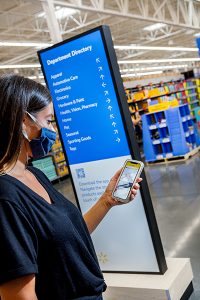McMillon: 'Our ability to adapt quickly has been crucial'
BENTONVILLE, Ark. — Walmart is reaping success by effectively pursuing an omnichannel strategy that capitalizes on its formidable assets — including 4,700 stores and warehouse clubs in the United States — while investing heavily in innovation.
It is not, however, a strategy limited to the U.S. Among Walmart’s international markets, Canada, Mexico and China in particular all have highly developed e-commerce capabilities (see story on page 32). Propelled in part by the COVID-19 pandemic, Walmart’s domestic and international businesses have seen e-commerce grow at a high double-digit pace.
 “With the outbreak of COVID-19 the retail world clicked to a fast-forward, and our ability to adapt quickly has been crucial,” president and chief executive officer Doug McMillon told analysts during the recent third quarter conference call. “Changes in customer behavior have accelerated the shift to e-commerce and digital. We were well positioned to catch and ride these waves, given our previous work and investments. Our e-commerce and omnichannel penetration continued to rise, accelerating trends by two to three years in some cases. We’re convinced that most of the behavior change will persist beyond the pandemic, and that our combination of strong stores and emerging digital capabilities will be a winning formula.”
“With the outbreak of COVID-19 the retail world clicked to a fast-forward, and our ability to adapt quickly has been crucial,” president and chief executive officer Doug McMillon told analysts during the recent third quarter conference call. “Changes in customer behavior have accelerated the shift to e-commerce and digital. We were well positioned to catch and ride these waves, given our previous work and investments. Our e-commerce and omnichannel penetration continued to rise, accelerating trends by two to three years in some cases. We’re convinced that most of the behavior change will persist beyond the pandemic, and that our combination of strong stores and emerging digital capabilities will be a winning formula.”
Walmart owes much of its recent success to McMillon’s far-sighted leadership, particularly his readiness to contemplate and envision a future shaped by rapid ongoing change. He has instilled and encouraged an innovation mindset at Walmart, demanding creativity, decisiveness and speed from his leadership team. The world’s largest retailer is consequently transforming itself to provide customers the experience they prefer while saving them money. For those reasons, the editors of Mass Market Retailers have selected Walmart as the Omnichannel Retailer of the Year for 2020.
Needless to say, Walmart’s omnichannel ambitions depend on the continued success of its rapidly growing e-commerce business. As McMillon noted, the changes in shopping behavior triggered by the COVID-19 outbreak have vaulted e-commerce and omnichannel growth ahead by years. But that unexpected progress would not have been possible had the company not positioned itself for rapid growth by investing in technology, its supply chain and its associates.
For example, in 2015 the company launched a cross-functional initiative dubbed Legacy that was intended to pave the way for an omnichannel future. It was led by Kathryn McLay, now president and CEO of Sam’s Club, but who then had recently joined Walmart as vice president of U.S. finance and strategy.
“We were focused on winning with customers by providing the first omni seamless shopping experience at scale,” she recalled during a recent interview. “Much of the success of that initiative was behind the scenes, shoring up our operations and merchandising strategy, and setting the groundwork for initiatives that are coming to light now, or are still to come.”
McLay also led a major overhaul of Walmart’s supply chain that focused on redesigning the flow of product from suppliers to store shelves, thereby creating a digitally connected supply chain. Working with its suppliers, Walmart developed a metric known as “on-time, in-full” (OTIF) that has enabled the company to better track and manage inventory flow through more accurate forecasting. According to McLay, it has been a major win for the company and has greatly improved in-stock performance.
This was some of the key foundational work, along with huge investments in associate pay, benefits and training, that McMillon referred to when he addressed analysts in 2018. It made possible a 37% increase in e-commerce sales for fiscal 2020 (which ended in January 2020). With the impetus provided by COVID-19, e-commerce for Walmart U.S. soared 79% in the third quarter of fiscal 2021, while Sam’s Club posted a 41% rise.
 Those growth figures in part reflect the value of Walmart’s store base in enabling the retailer to offer the flexibility and convenience of omnichannel shopping. As executives often point out, there is a Walmart or Neighborhood Market or Sam’s Club within 10 miles of 90% of the U.S. population.
Those growth figures in part reflect the value of Walmart’s store base in enabling the retailer to offer the flexibility and convenience of omnichannel shopping. As executives often point out, there is a Walmart or Neighborhood Market or Sam’s Club within 10 miles of 90% of the U.S. population.
The company has moved aggressively to increase its use of that store base. At the beginning of 2020, Walmart provided home delivery from 1,600 stores, which allowed it to service half the population. In April, it significantly enhanced its convenience offer by introducing Express Delivery, which allows customers to order from more than 160,000 food, consumables and general merchandise items and have their purchases delivered in less than two hours.
By late November, Express Delivery had been extended to 2,800 locations covering two-thirds of the country, while 3,700 stores were providing the option of curbside pickup.
“It’s essentially the same process for delivery as it is for a pickup order, it’s just the associate is putting the order in a delivery driver’s truck instead of the customer’s,” explained John Furner, president and CEO of Walmart U.S., last February. “In same-day delivery, that’s what a lot of customers want, and we love our position there. We’ve got different options for delivery, things like third-parties, associate delivery, and we’ve also launched our own Spark Delivery network.”
Increased reliance on its stores to fulfill commerce orders has had another benefit for customers: faster delivery.
“We’ll use our existing local delivery capabilities to get orders to customers faster while reducing the load on our online fulfillment centers,” explained Tom Ward, senior vice president of customer product.
Last November Walmart revealed another innovation: pop-up e-commerce distribution centers (eDCs) in 42 of its regional distribution centers. As a result, facilities that had previously been devoted to supplying stores are now also fulfilling online orders. The initiative was made possible by technological innovation: Walmart’s multichannel sourcing engine (MCSE), a computer application that can scan the entire Walmart fulfillment network in less than a second and assign orders to stores, fulfillment centers or eDCs, depending on which would be the fastest and most efficient way.
Clearly, Walmart is determined to shape its future by constant innovation combined with maximizing the value of its existing assets to meet customers’ evolving needs and desires. As McMillon remarked, it looks like a winning formula.




You must be logged in to post a comment Login